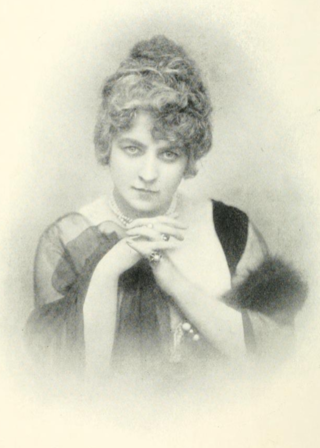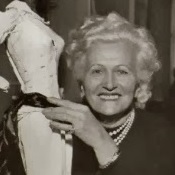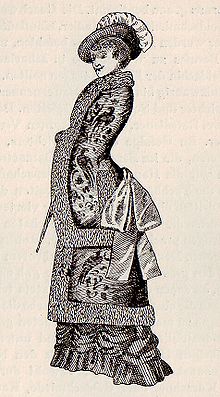
Fashion in the 1890s in Western countries is characterized by long elegant lines, tall collars, and the rise of sportswear. It was an era of great dress reforms led by the invention of the drop-frame safety bicycle, which allowed women the opportunity to ride bicycles more comfortably, and therefore, created the need for appropriate clothing.
Daniel Hechter is a French-Belgian fashion designer who is sometimes referred to as the inventor of ready-to-wear (prêt-à-porter). He is also known for being the president of Paris Saint-Germain F.C. from 1974 to 1978, having designed the club's famous home shirt.

An evening gown, evening dress or gown is a long dress usually worn at formal occasions. The drop ranges from ballerina, tea, to full-length. Such gowns are typically worn with evening gloves. Evening gowns are usually made of luxurious fabrics such as chiffon, velvet, satin, or organza. Silk is a popular fibre for many evening gowns. Although the terms are used interchangeably, ball gowns and evening gowns differ in that a ball gown will always have a full skirt and a fitted bodice, while an evening gown can be any silhouette—sheath, mermaid, fit and flare, A-line, or trumpet-shaped—and may have straps, halters or even sleeves.

The Delphos gown is a finely pleated silk dress first created in about 1907 by French designer Henriette Negrin and her husband, Mariano Fortuny y Madrazo (1871–1949). They produced the gowns until about 1950. It was inspired by, and named after, a classical Greek statue, the Charioteer of Delphi. Since the 1970s, these gowns have been desirable and collectable pieces of vintage clothing, with one selling for a world record price of $10,000 in December 2001.

Callot Soeurs was one of the leading fashion design houses of the 1910s and 1920s.

A bedgown is an article of women's clothing for the upper body, usually thigh-length and wrapping or tying in front. Bedgowns of lightweight printed cotton fabric were fashionable at-home morning wear in the 18th century. Over time, bedgowns became the staple upper garment of British and American female working-class street wear from the 18th to early 19th centuries, worn over petticoats and often topped with an apron. Made of sturdy cotton, linen, wool or linsey-woolsey, these bedgowns were simply cut to a T-shaped pattern, and were worn overlapped in front or with the front skirts cutaway. The term "bed gown" to describe this item of clothing was used as late as 1876.

Taffeta is a crisp, smooth, plain woven fabric made from silk, nylon, cuprammonium rayons, acetate, or polyester. The word came into Middle English via Old French and Old Italian, which borrowed the Persian word tāfta (تافته), which means "silk" or "linen cloth". As clothing, it is used in ball gowns, wedding dresses, and corsets, and in interior decoration for curtains or wallcovering. It tends to yield a stiff, starched-like cloth that holds its shape better than many other fabrics and does not sag or drape.

Jeanne Paquin (1869–1936) was a leading French fashion designer, known for her resolutely modern and innovative designs. She was the first major female couturier and one of the pioneers of the modern fashion business.

Metal corsets are a type of historical corset or bodice made entirely out of metal, usually iron or steel. The metal corset was popularly claimed to have been introduced to France by Catherine de' Medici in the 16th century, although this is now considered a myth. The idea that such garments were worn for fashionable purposes is debatable, with fashion historians now regarding such claims sceptically. Many of the original metal bodices that have survived are now believed to have been intended for medical purposes as orthopaedic support garments and back braces. Such garments were described by the French army surgeon Ambroise Paré in the 16th century as a remedy for the "crookednesse of the Bodie."

Shot silk is a fabric which is made up of silk woven from warp and weft yarns of two or more colours producing an iridescent appearance. A "shot" is a single throw of the bobbin that carries the weft thread through the warp, and shot silk colours can be described as "[warp colour] shot with [weft colour]." The weaving technique can also be applied to other fibres such as cotton, linen, and synthetics.

Harem pants or harem trousers are baggy, long pants caught in at the ankle. Early on, the style was also called a harem skirt. The original so-called 'harem pants/skirts' were introduced to Western fashion by designers such as Paul Poiret around 1910, although they themselves were inspired by Middle East styles, and by şalvar. The term 'harem pants' subsequently became popular in the West as a generic term for baggy trousers caught in at the ankle that suggest the Turkish style, or similar styles such as bloomers, the South Asian shalwar and patiala salwar; the Bosnian dimije; sirwal ; and the Ukrainian sharovary.
Gérard Albouy (1912–1985), often known by the name Ouy, was a French milliner. Between 1938 and 1964, he operated a Parisian hat shop called Albouy that was known for its decorative, baroque-style hats. Notable works include veiled hats made of recycled newspaper, which he constructed during the German occupation of France, and the mollusque, a hat made without interlining. Albouy's hobbies included painting and collecting art.

Marie-Louise Bruyère, mostly known as Madame Bruyère, or simply as Bruyère, was a French fashion designer of the 1930s, 1940s and 1950s, operating out of Paris, and importing her fashion lines abroad.

Babani, founded in Paris in 1894 by Vitaldi Babani, was a fashion house based on the Boulevard Haussmann specialising in imported exotic goods, including artworks and handicrafts, and from the 1910s onwards, original garments inspired by their imported merchandise. The business closed in 1940.

Warp printing is a fabric production method which combines textile printing and weaving to create a distinctively patterned fabric, usually in silk. The warp threads of the fabric are printed before weaving to create a softly blurred, vague pastel-coloured pattern. It was particularly fashionable in the eighteenth century for summer wear.

Robert Piguet was a Swiss-born, Paris-based fashion designer who is mainly remembered for training Christian Dior and Hubert de Givenchy. The Piguet fashion house ran from 1933 to 1951; since then, the brand Robert Piguet has been associated exclusively with fragrances.

Princess line or princess dress describes a woman's fitted dress or other garment cut in long panels without a horizontal join or separation at the waist. Instead of relying on darts to shape the garment, the fit is achieved with long seams and shaped pattern pieces. A rarely used alternative name for the princess line was French-dart-line dress.

Mathilde Flögl was an Austrian artist and designer. She worked in several different mediums including textiles, glass, and paint. Flögl was also a member of the Wiener Werkstätte, literally translated to the Vienna Workshops. This group was part of the Arts and Crafts movement dedicated to elegance, utility, and appropriateness. They aimed to refine art and expand it to all fields of life. Flögl was very active in this group, she participated in most of the major Wiener Werkstätte exhibitions. Currently, the Viennese Museum of Applied Arts houses over 1,600 of Flögl's works from when she was involved with the Wiener Werkstätte. Among these are many independent works and collaborations with other individuals in the group. Notable members of the Wiener Werkstätte include two of its founders Josef Hoffman and Koloman Moser as well as Gustav Klimt, among others. For the group's 25th anniversary, Flögl amassed, arranged, wrote, and published, The Wiener Werkstatte, 1903-1928: The Evolution of the Modern Applied Arts. The book itself was a work of art using elaborate materials and decoration in its pages.

A casaquin is a short-length closely fitted coat worn by middle- and upper-class women during the 18th century. The garment was popular in both France and Italy. A casaquin was made from linen which was then covered by embroidery, silk and lace to decorate. The design was influenced by religious beliefs or events as well as reflecting on stylistic features of the time or of individual designers. Casaquins were worn by a range of females - from working-class women to upper-class ladies. The casaquin even influenced women from the Netherlands during the 18th century to introduce their own version of a casaquin called a "Kassekijntje".
Akiko Fukai is a Japanese curator of fashion and textile arts.

















